Analyzing Financial Statements in the Travel and Tourism Sector
VerifiedAdded on 2020/06/04
|13
|3837
|52
AI Summary
The report investigates how CVP analysis aids in managerial decisions in the travel and tourism industry, emphasizing its role in enhancing performance. Through case studies and specific financial statement evaluations—such as income and balance sheets—the assignment demonstrates how management accounting information supports strategic decision-making. Furthermore, it explores various funding sources like loans, equity, and retained earnings for capital projects within this sector.

FINANCE AND FUNDING
Paraphrase This Document
Need a fresh take? Get an instant paraphrase of this document with our AI Paraphraser
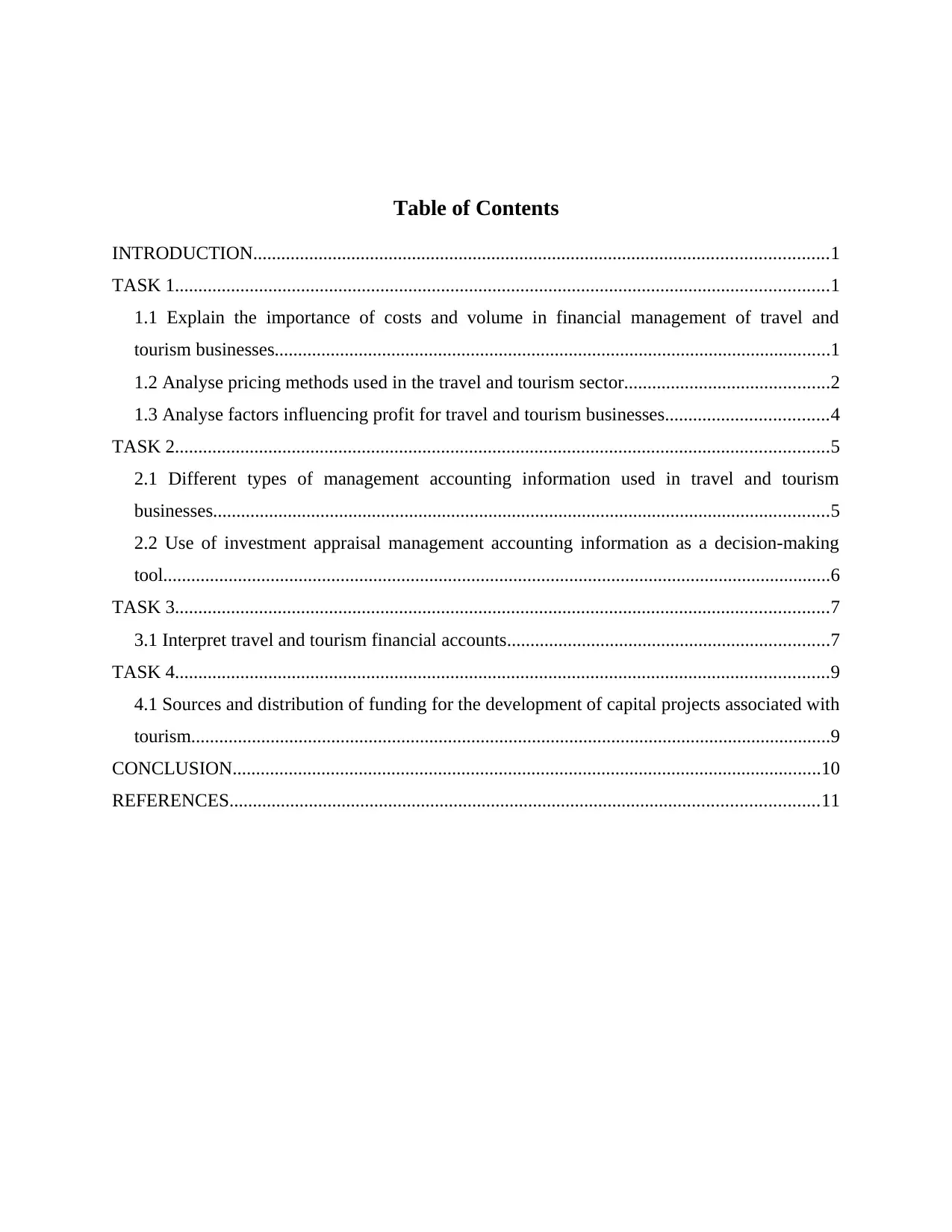
Table of Contents
INTRODUCTION...........................................................................................................................1
TASK 1............................................................................................................................................1
1.1 Explain the importance of costs and volume in financial management of travel and
tourism businesses.......................................................................................................................1
1.2 Analyse pricing methods used in the travel and tourism sector............................................2
1.3 Analyse factors influencing profit for travel and tourism businesses...................................4
TASK 2............................................................................................................................................5
2.1 Different types of management accounting information used in travel and tourism
businesses....................................................................................................................................5
2.2 Use of investment appraisal management accounting information as a decision-making
tool...............................................................................................................................................6
TASK 3............................................................................................................................................7
3.1 Interpret travel and tourism financial accounts.....................................................................7
TASK 4............................................................................................................................................9
4.1 Sources and distribution of funding for the development of capital projects associated with
tourism.........................................................................................................................................9
CONCLUSION..............................................................................................................................10
REFERENCES..............................................................................................................................11
INTRODUCTION...........................................................................................................................1
TASK 1............................................................................................................................................1
1.1 Explain the importance of costs and volume in financial management of travel and
tourism businesses.......................................................................................................................1
1.2 Analyse pricing methods used in the travel and tourism sector............................................2
1.3 Analyse factors influencing profit for travel and tourism businesses...................................4
TASK 2............................................................................................................................................5
2.1 Different types of management accounting information used in travel and tourism
businesses....................................................................................................................................5
2.2 Use of investment appraisal management accounting information as a decision-making
tool...............................................................................................................................................6
TASK 3............................................................................................................................................7
3.1 Interpret travel and tourism financial accounts.....................................................................7
TASK 4............................................................................................................................................9
4.1 Sources and distribution of funding for the development of capital projects associated with
tourism.........................................................................................................................................9
CONCLUSION..............................................................................................................................10
REFERENCES..............................................................................................................................11
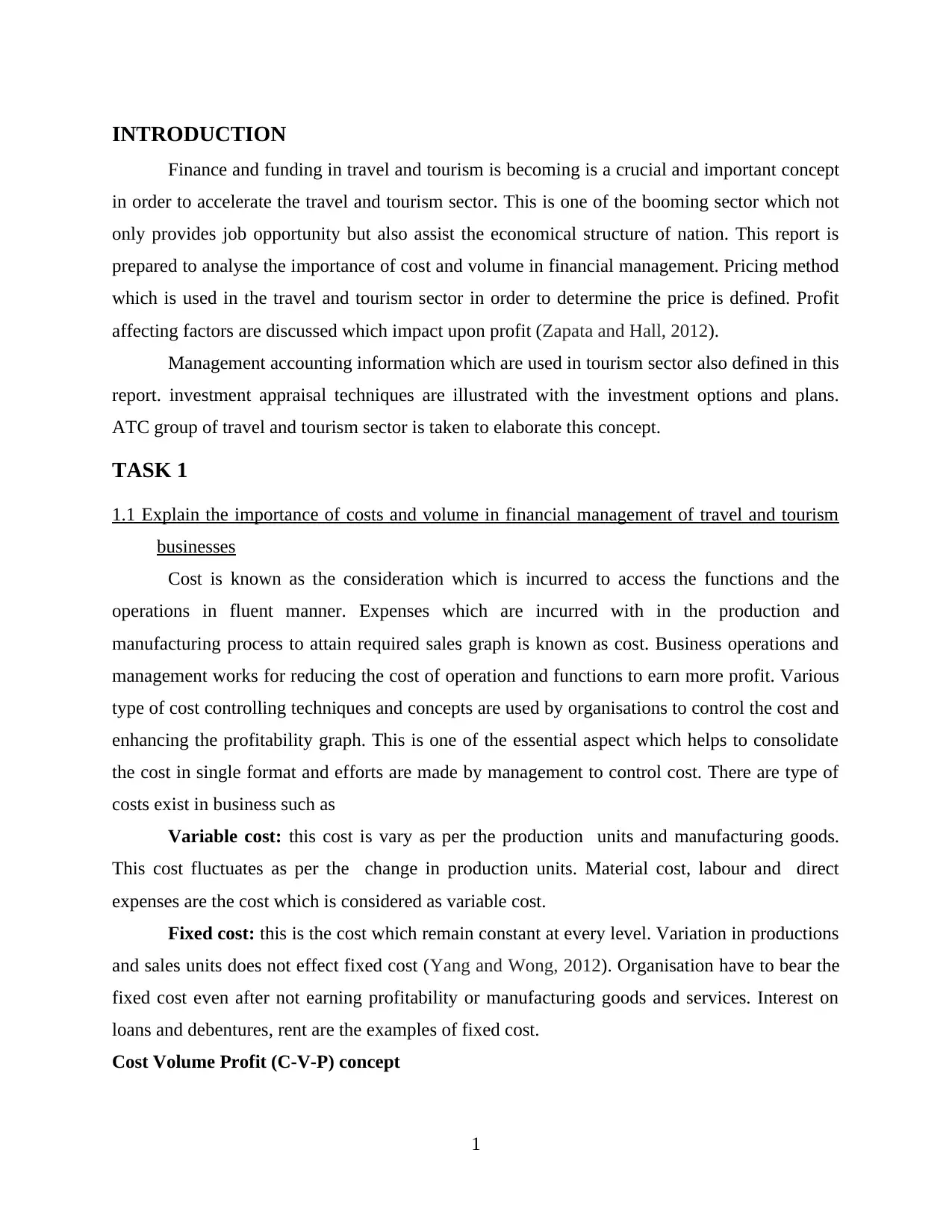
INTRODUCTION
Finance and funding in travel and tourism is becoming is a crucial and important concept
in order to accelerate the travel and tourism sector. This is one of the booming sector which not
only provides job opportunity but also assist the economical structure of nation. This report is
prepared to analyse the importance of cost and volume in financial management. Pricing method
which is used in the travel and tourism sector in order to determine the price is defined. Profit
affecting factors are discussed which impact upon profit (Zapata and Hall, 2012).
Management accounting information which are used in tourism sector also defined in this
report. investment appraisal techniques are illustrated with the investment options and plans.
ATC group of travel and tourism sector is taken to elaborate this concept.
TASK 1
1.1 Explain the importance of costs and volume in financial management of travel and tourism
businesses
Cost is known as the consideration which is incurred to access the functions and the
operations in fluent manner. Expenses which are incurred with in the production and
manufacturing process to attain required sales graph is known as cost. Business operations and
management works for reducing the cost of operation and functions to earn more profit. Various
type of cost controlling techniques and concepts are used by organisations to control the cost and
enhancing the profitability graph. This is one of the essential aspect which helps to consolidate
the cost in single format and efforts are made by management to control cost. There are type of
costs exist in business such as
Variable cost: this cost is vary as per the production units and manufacturing goods.
This cost fluctuates as per the change in production units. Material cost, labour and direct
expenses are the cost which is considered as variable cost.
Fixed cost: this is the cost which remain constant at every level. Variation in productions
and sales units does not effect fixed cost (Yang and Wong, 2012). Organisation have to bear the
fixed cost even after not earning profitability or manufacturing goods and services. Interest on
loans and debentures, rent are the examples of fixed cost.
Cost Volume Profit (C-V-P) concept
1
Finance and funding in travel and tourism is becoming is a crucial and important concept
in order to accelerate the travel and tourism sector. This is one of the booming sector which not
only provides job opportunity but also assist the economical structure of nation. This report is
prepared to analyse the importance of cost and volume in financial management. Pricing method
which is used in the travel and tourism sector in order to determine the price is defined. Profit
affecting factors are discussed which impact upon profit (Zapata and Hall, 2012).
Management accounting information which are used in tourism sector also defined in this
report. investment appraisal techniques are illustrated with the investment options and plans.
ATC group of travel and tourism sector is taken to elaborate this concept.
TASK 1
1.1 Explain the importance of costs and volume in financial management of travel and tourism
businesses
Cost is known as the consideration which is incurred to access the functions and the
operations in fluent manner. Expenses which are incurred with in the production and
manufacturing process to attain required sales graph is known as cost. Business operations and
management works for reducing the cost of operation and functions to earn more profit. Various
type of cost controlling techniques and concepts are used by organisations to control the cost and
enhancing the profitability graph. This is one of the essential aspect which helps to consolidate
the cost in single format and efforts are made by management to control cost. There are type of
costs exist in business such as
Variable cost: this cost is vary as per the production units and manufacturing goods.
This cost fluctuates as per the change in production units. Material cost, labour and direct
expenses are the cost which is considered as variable cost.
Fixed cost: this is the cost which remain constant at every level. Variation in productions
and sales units does not effect fixed cost (Yang and Wong, 2012). Organisation have to bear the
fixed cost even after not earning profitability or manufacturing goods and services. Interest on
loans and debentures, rent are the examples of fixed cost.
Cost Volume Profit (C-V-P) concept
1
⊘ This is a preview!⊘
Do you want full access?
Subscribe today to unlock all pages.

Trusted by 1+ million students worldwide
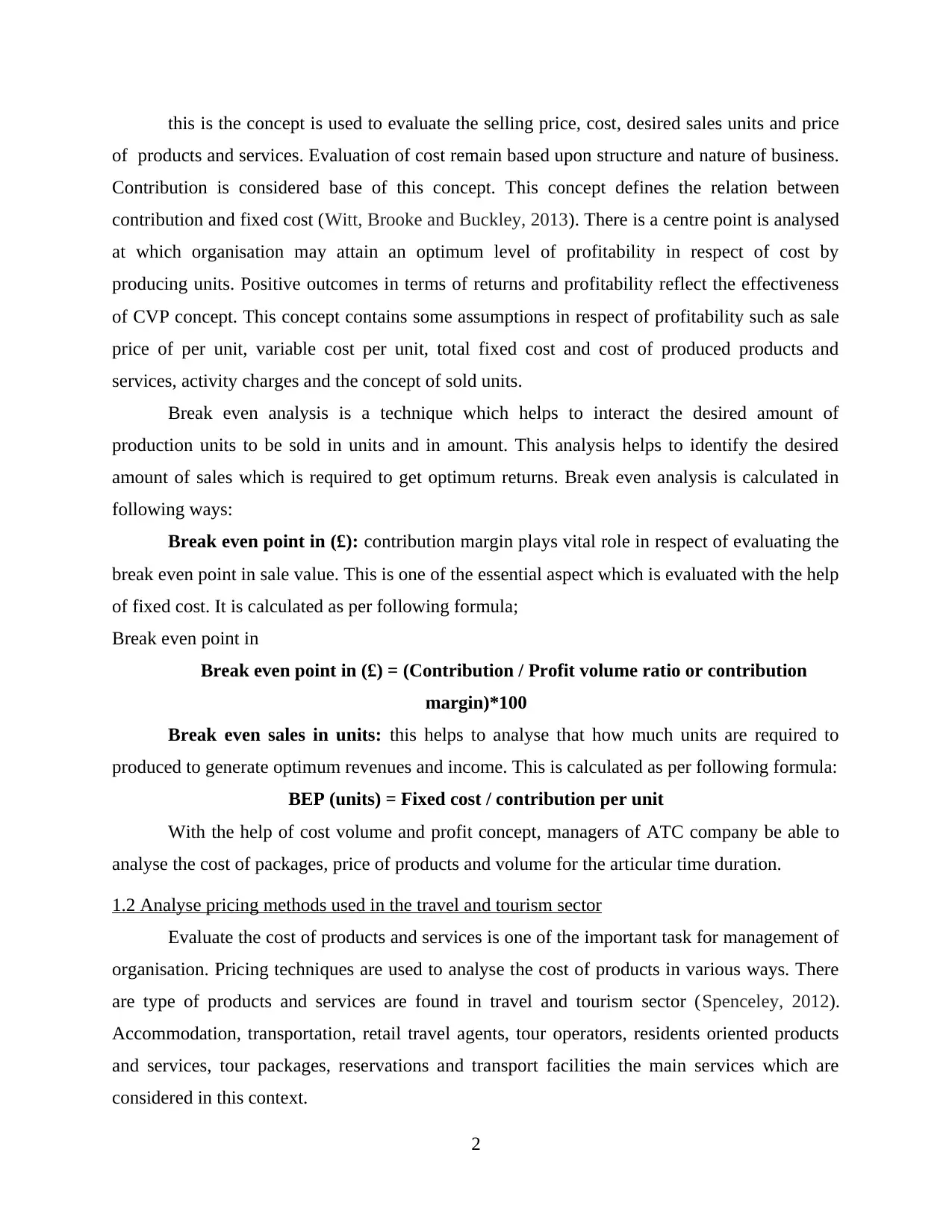
this is the concept is used to evaluate the selling price, cost, desired sales units and price
of products and services. Evaluation of cost remain based upon structure and nature of business.
Contribution is considered base of this concept. This concept defines the relation between
contribution and fixed cost (Witt, Brooke and Buckley, 2013). There is a centre point is analysed
at which organisation may attain an optimum level of profitability in respect of cost by
producing units. Positive outcomes in terms of returns and profitability reflect the effectiveness
of CVP concept. This concept contains some assumptions in respect of profitability such as sale
price of per unit, variable cost per unit, total fixed cost and cost of produced products and
services, activity charges and the concept of sold units.
Break even analysis is a technique which helps to interact the desired amount of
production units to be sold in units and in amount. This analysis helps to identify the desired
amount of sales which is required to get optimum returns. Break even analysis is calculated in
following ways:
Break even point in (£): contribution margin plays vital role in respect of evaluating the
break even point in sale value. This is one of the essential aspect which is evaluated with the help
of fixed cost. It is calculated as per following formula;
Break even point in
Break even point in (£) = (Contribution / Profit volume ratio or contribution
margin)*100
Break even sales in units: this helps to analyse that how much units are required to
produced to generate optimum revenues and income. This is calculated as per following formula:
BEP (units) = Fixed cost / contribution per unit
With the help of cost volume and profit concept, managers of ATC company be able to
analyse the cost of packages, price of products and volume for the articular time duration.
1.2 Analyse pricing methods used in the travel and tourism sector
Evaluate the cost of products and services is one of the important task for management of
organisation. Pricing techniques are used to analyse the cost of products in various ways. There
are type of products and services are found in travel and tourism sector (Spenceley, 2012).
Accommodation, transportation, retail travel agents, tour operators, residents oriented products
and services, tour packages, reservations and transport facilities the main services which are
considered in this context.
2
of products and services. Evaluation of cost remain based upon structure and nature of business.
Contribution is considered base of this concept. This concept defines the relation between
contribution and fixed cost (Witt, Brooke and Buckley, 2013). There is a centre point is analysed
at which organisation may attain an optimum level of profitability in respect of cost by
producing units. Positive outcomes in terms of returns and profitability reflect the effectiveness
of CVP concept. This concept contains some assumptions in respect of profitability such as sale
price of per unit, variable cost per unit, total fixed cost and cost of produced products and
services, activity charges and the concept of sold units.
Break even analysis is a technique which helps to interact the desired amount of
production units to be sold in units and in amount. This analysis helps to identify the desired
amount of sales which is required to get optimum returns. Break even analysis is calculated in
following ways:
Break even point in (£): contribution margin plays vital role in respect of evaluating the
break even point in sale value. This is one of the essential aspect which is evaluated with the help
of fixed cost. It is calculated as per following formula;
Break even point in
Break even point in (£) = (Contribution / Profit volume ratio or contribution
margin)*100
Break even sales in units: this helps to analyse that how much units are required to
produced to generate optimum revenues and income. This is calculated as per following formula:
BEP (units) = Fixed cost / contribution per unit
With the help of cost volume and profit concept, managers of ATC company be able to
analyse the cost of packages, price of products and volume for the articular time duration.
1.2 Analyse pricing methods used in the travel and tourism sector
Evaluate the cost of products and services is one of the important task for management of
organisation. Pricing techniques are used to analyse the cost of products in various ways. There
are type of products and services are found in travel and tourism sector (Spenceley, 2012).
Accommodation, transportation, retail travel agents, tour operators, residents oriented products
and services, tour packages, reservations and transport facilities the main services which are
considered in this context.
2
Paraphrase This Document
Need a fresh take? Get an instant paraphrase of this document with our AI Paraphraser
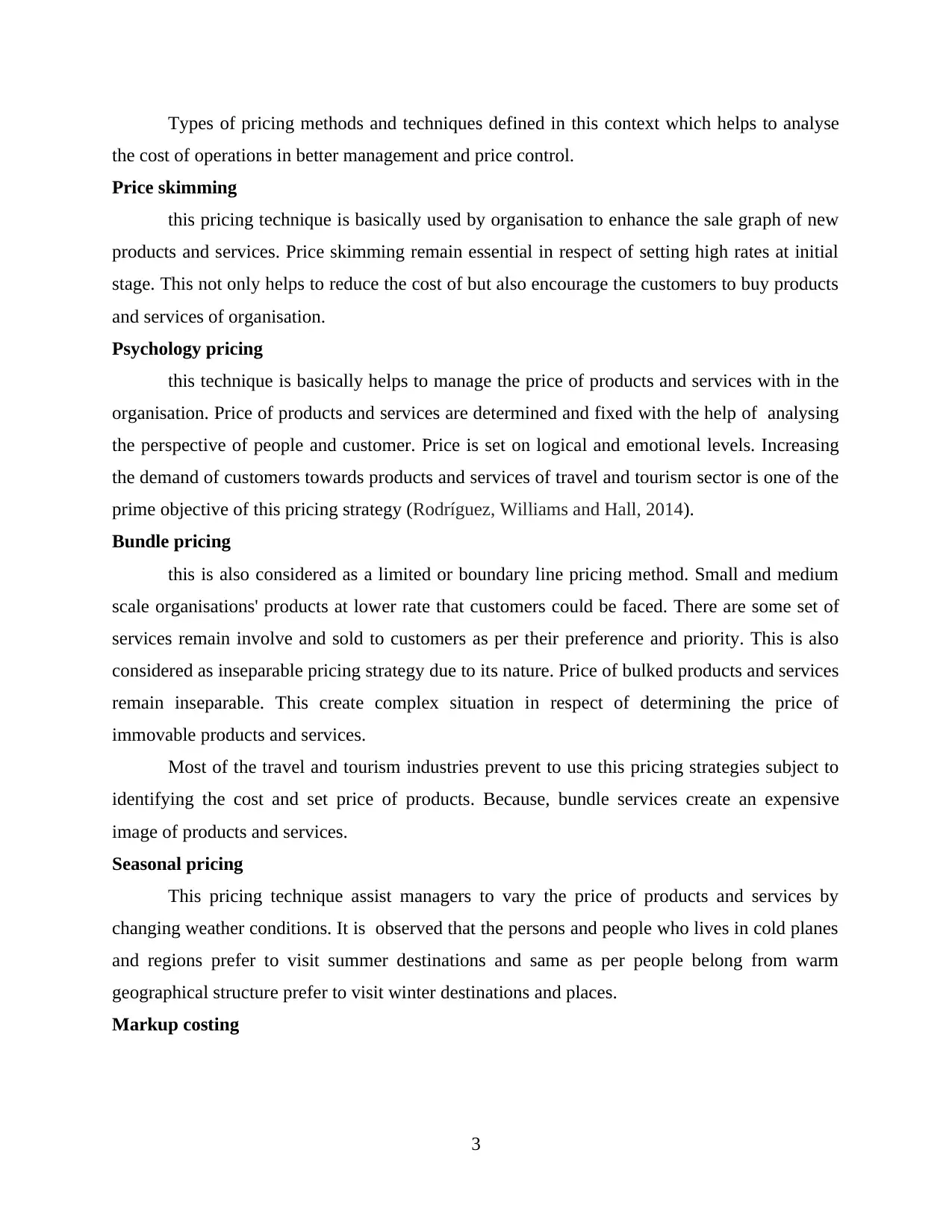
Types of pricing methods and techniques defined in this context which helps to analyse
the cost of operations in better management and price control.
Price skimming
this pricing technique is basically used by organisation to enhance the sale graph of new
products and services. Price skimming remain essential in respect of setting high rates at initial
stage. This not only helps to reduce the cost of but also encourage the customers to buy products
and services of organisation.
Psychology pricing
this technique is basically helps to manage the price of products and services with in the
organisation. Price of products and services are determined and fixed with the help of analysing
the perspective of people and customer. Price is set on logical and emotional levels. Increasing
the demand of customers towards products and services of travel and tourism sector is one of the
prime objective of this pricing strategy (Rodríguez, Williams and Hall, 2014).
Bundle pricing
this is also considered as a limited or boundary line pricing method. Small and medium
scale organisations' products at lower rate that customers could be faced. There are some set of
services remain involve and sold to customers as per their preference and priority. This is also
considered as inseparable pricing strategy due to its nature. Price of bulked products and services
remain inseparable. This create complex situation in respect of determining the price of
immovable products and services.
Most of the travel and tourism industries prevent to use this pricing strategies subject to
identifying the cost and set price of products. Because, bundle services create an expensive
image of products and services.
Seasonal pricing
This pricing technique assist managers to vary the price of products and services by
changing weather conditions. It is observed that the persons and people who lives in cold planes
and regions prefer to visit summer destinations and same as per people belong from warm
geographical structure prefer to visit winter destinations and places.
Markup costing
3
the cost of operations in better management and price control.
Price skimming
this pricing technique is basically used by organisation to enhance the sale graph of new
products and services. Price skimming remain essential in respect of setting high rates at initial
stage. This not only helps to reduce the cost of but also encourage the customers to buy products
and services of organisation.
Psychology pricing
this technique is basically helps to manage the price of products and services with in the
organisation. Price of products and services are determined and fixed with the help of analysing
the perspective of people and customer. Price is set on logical and emotional levels. Increasing
the demand of customers towards products and services of travel and tourism sector is one of the
prime objective of this pricing strategy (Rodríguez, Williams and Hall, 2014).
Bundle pricing
this is also considered as a limited or boundary line pricing method. Small and medium
scale organisations' products at lower rate that customers could be faced. There are some set of
services remain involve and sold to customers as per their preference and priority. This is also
considered as inseparable pricing strategy due to its nature. Price of bulked products and services
remain inseparable. This create complex situation in respect of determining the price of
immovable products and services.
Most of the travel and tourism industries prevent to use this pricing strategies subject to
identifying the cost and set price of products. Because, bundle services create an expensive
image of products and services.
Seasonal pricing
This pricing technique assist managers to vary the price of products and services by
changing weather conditions. It is observed that the persons and people who lives in cold planes
and regions prefer to visit summer destinations and same as per people belong from warm
geographical structure prefer to visit winter destinations and places.
Markup costing
3
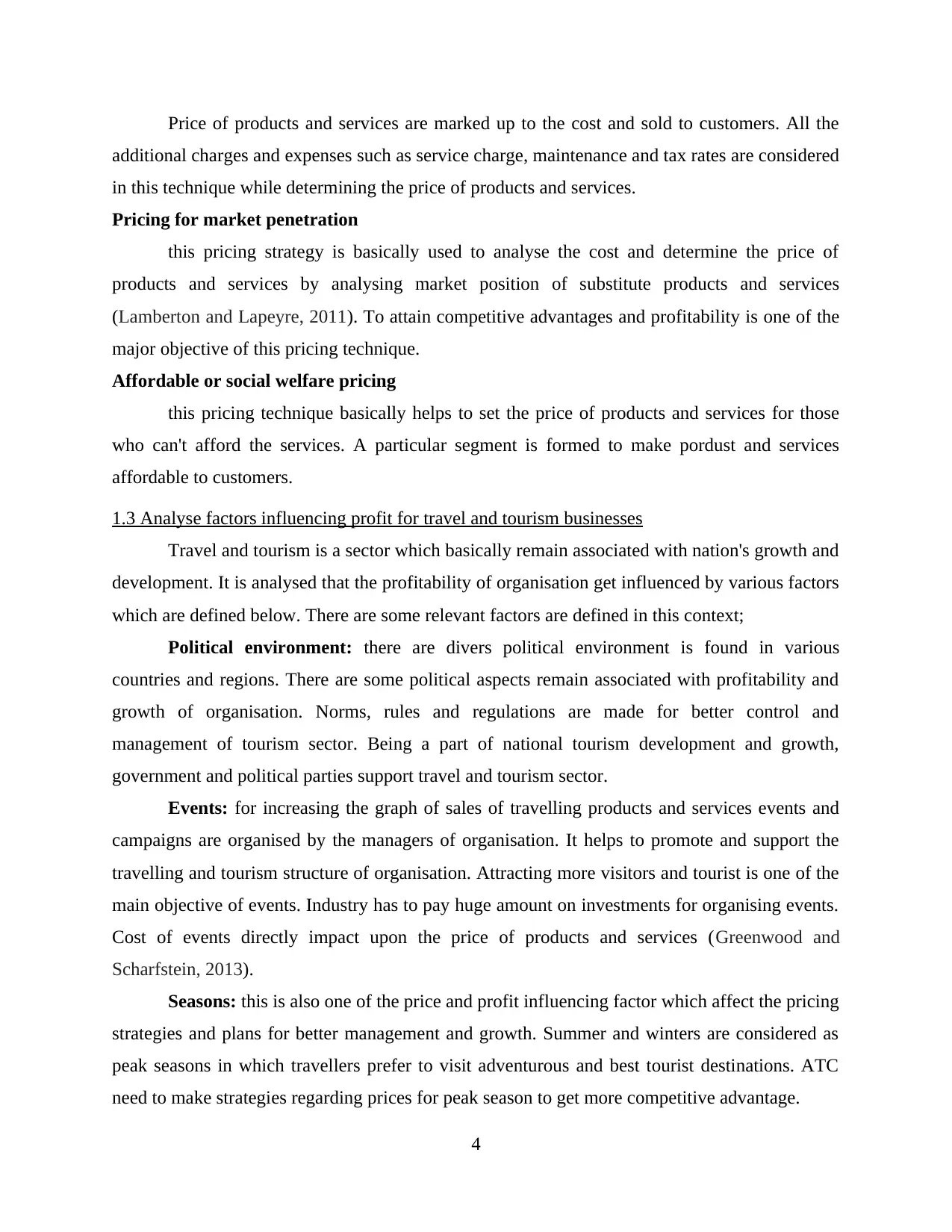
Price of products and services are marked up to the cost and sold to customers. All the
additional charges and expenses such as service charge, maintenance and tax rates are considered
in this technique while determining the price of products and services.
Pricing for market penetration
this pricing strategy is basically used to analyse the cost and determine the price of
products and services by analysing market position of substitute products and services
(Lamberton and Lapeyre, 2011). To attain competitive advantages and profitability is one of the
major objective of this pricing technique.
Affordable or social welfare pricing
this pricing technique basically helps to set the price of products and services for those
who can't afford the services. A particular segment is formed to make pordust and services
affordable to customers.
1.3 Analyse factors influencing profit for travel and tourism businesses
Travel and tourism is a sector which basically remain associated with nation's growth and
development. It is analysed that the profitability of organisation get influenced by various factors
which are defined below. There are some relevant factors are defined in this context;
Political environment: there are divers political environment is found in various
countries and regions. There are some political aspects remain associated with profitability and
growth of organisation. Norms, rules and regulations are made for better control and
management of tourism sector. Being a part of national tourism development and growth,
government and political parties support travel and tourism sector.
Events: for increasing the graph of sales of travelling products and services events and
campaigns are organised by the managers of organisation. It helps to promote and support the
travelling and tourism structure of organisation. Attracting more visitors and tourist is one of the
main objective of events. Industry has to pay huge amount on investments for organising events.
Cost of events directly impact upon the price of products and services (Greenwood and
Scharfstein, 2013).
Seasons: this is also one of the price and profit influencing factor which affect the pricing
strategies and plans for better management and growth. Summer and winters are considered as
peak seasons in which travellers prefer to visit adventurous and best tourist destinations. ATC
need to make strategies regarding prices for peak season to get more competitive advantage.
4
additional charges and expenses such as service charge, maintenance and tax rates are considered
in this technique while determining the price of products and services.
Pricing for market penetration
this pricing strategy is basically used to analyse the cost and determine the price of
products and services by analysing market position of substitute products and services
(Lamberton and Lapeyre, 2011). To attain competitive advantages and profitability is one of the
major objective of this pricing technique.
Affordable or social welfare pricing
this pricing technique basically helps to set the price of products and services for those
who can't afford the services. A particular segment is formed to make pordust and services
affordable to customers.
1.3 Analyse factors influencing profit for travel and tourism businesses
Travel and tourism is a sector which basically remain associated with nation's growth and
development. It is analysed that the profitability of organisation get influenced by various factors
which are defined below. There are some relevant factors are defined in this context;
Political environment: there are divers political environment is found in various
countries and regions. There are some political aspects remain associated with profitability and
growth of organisation. Norms, rules and regulations are made for better control and
management of tourism sector. Being a part of national tourism development and growth,
government and political parties support travel and tourism sector.
Events: for increasing the graph of sales of travelling products and services events and
campaigns are organised by the managers of organisation. It helps to promote and support the
travelling and tourism structure of organisation. Attracting more visitors and tourist is one of the
main objective of events. Industry has to pay huge amount on investments for organising events.
Cost of events directly impact upon the price of products and services (Greenwood and
Scharfstein, 2013).
Seasons: this is also one of the price and profit influencing factor which affect the pricing
strategies and plans for better management and growth. Summer and winters are considered as
peak seasons in which travellers prefer to visit adventurous and best tourist destinations. ATC
need to make strategies regarding prices for peak season to get more competitive advantage.
4
⊘ This is a preview!⊘
Do you want full access?
Subscribe today to unlock all pages.

Trusted by 1+ million students worldwide
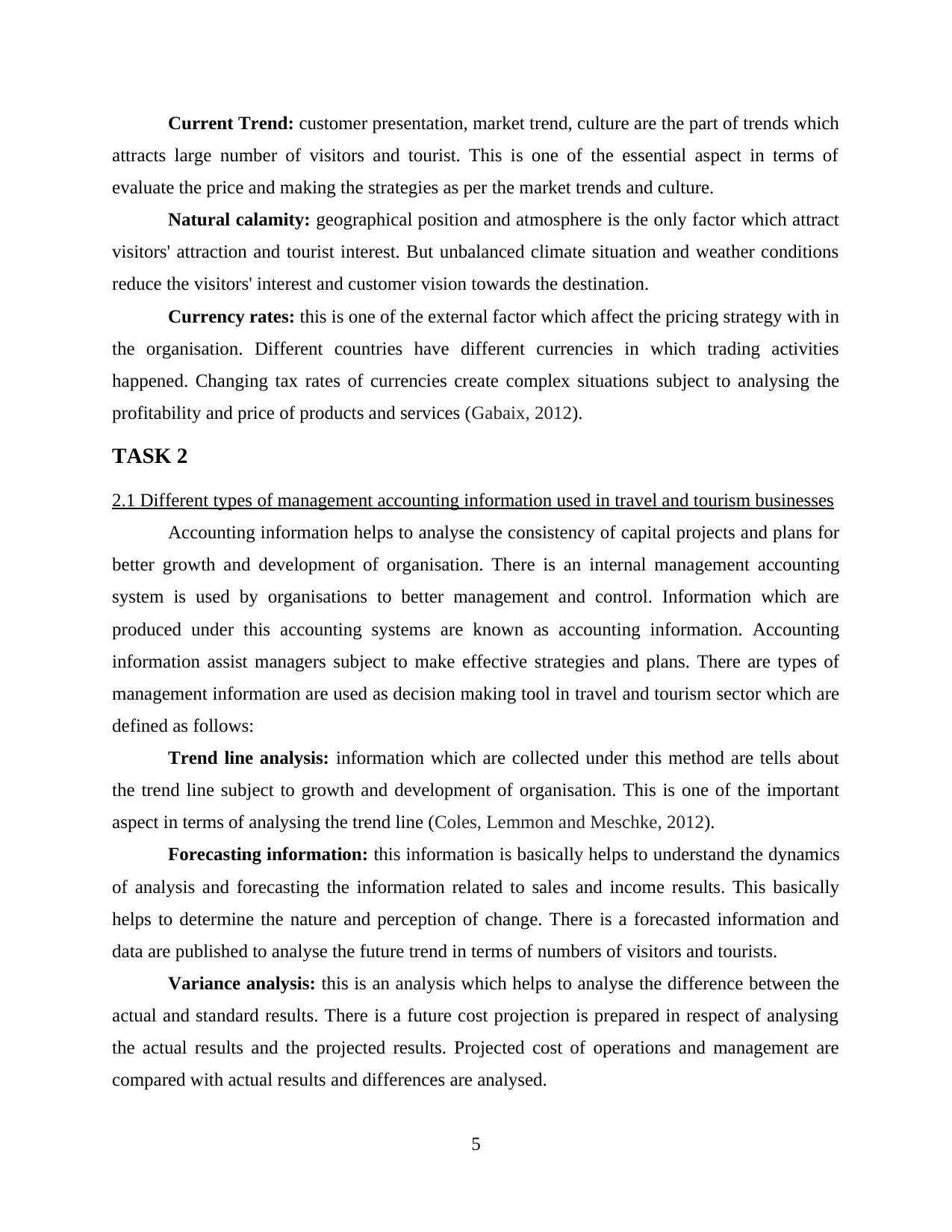
Current Trend: customer presentation, market trend, culture are the part of trends which
attracts large number of visitors and tourist. This is one of the essential aspect in terms of
evaluate the price and making the strategies as per the market trends and culture.
Natural calamity: geographical position and atmosphere is the only factor which attract
visitors' attraction and tourist interest. But unbalanced climate situation and weather conditions
reduce the visitors' interest and customer vision towards the destination.
Currency rates: this is one of the external factor which affect the pricing strategy with in
the organisation. Different countries have different currencies in which trading activities
happened. Changing tax rates of currencies create complex situations subject to analysing the
profitability and price of products and services (Gabaix, 2012).
TASK 2
2.1 Different types of management accounting information used in travel and tourism businesses
Accounting information helps to analyse the consistency of capital projects and plans for
better growth and development of organisation. There is an internal management accounting
system is used by organisations to better management and control. Information which are
produced under this accounting systems are known as accounting information. Accounting
information assist managers subject to make effective strategies and plans. There are types of
management information are used as decision making tool in travel and tourism sector which are
defined as follows:
Trend line analysis: information which are collected under this method are tells about
the trend line subject to growth and development of organisation. This is one of the important
aspect in terms of analysing the trend line (Coles, Lemmon and Meschke, 2012).
Forecasting information: this information is basically helps to understand the dynamics
of analysis and forecasting the information related to sales and income results. This basically
helps to determine the nature and perception of change. There is a forecasted information and
data are published to analyse the future trend in terms of numbers of visitors and tourists.
Variance analysis: this is an analysis which helps to analyse the difference between the
actual and standard results. There is a future cost projection is prepared in respect of analysing
the actual results and the projected results. Projected cost of operations and management are
compared with actual results and differences are analysed.
5
attracts large number of visitors and tourist. This is one of the essential aspect in terms of
evaluate the price and making the strategies as per the market trends and culture.
Natural calamity: geographical position and atmosphere is the only factor which attract
visitors' attraction and tourist interest. But unbalanced climate situation and weather conditions
reduce the visitors' interest and customer vision towards the destination.
Currency rates: this is one of the external factor which affect the pricing strategy with in
the organisation. Different countries have different currencies in which trading activities
happened. Changing tax rates of currencies create complex situations subject to analysing the
profitability and price of products and services (Gabaix, 2012).
TASK 2
2.1 Different types of management accounting information used in travel and tourism businesses
Accounting information helps to analyse the consistency of capital projects and plans for
better growth and development of organisation. There is an internal management accounting
system is used by organisations to better management and control. Information which are
produced under this accounting systems are known as accounting information. Accounting
information assist managers subject to make effective strategies and plans. There are types of
management information are used as decision making tool in travel and tourism sector which are
defined as follows:
Trend line analysis: information which are collected under this method are tells about
the trend line subject to growth and development of organisation. This is one of the important
aspect in terms of analysing the trend line (Coles, Lemmon and Meschke, 2012).
Forecasting information: this information is basically helps to understand the dynamics
of analysis and forecasting the information related to sales and income results. This basically
helps to determine the nature and perception of change. There is a forecasted information and
data are published to analyse the future trend in terms of numbers of visitors and tourists.
Variance analysis: this is an analysis which helps to analyse the difference between the
actual and standard results. There is a future cost projection is prepared in respect of analysing
the actual results and the projected results. Projected cost of operations and management are
compared with actual results and differences are analysed.
5
Paraphrase This Document
Need a fresh take? Get an instant paraphrase of this document with our AI Paraphraser
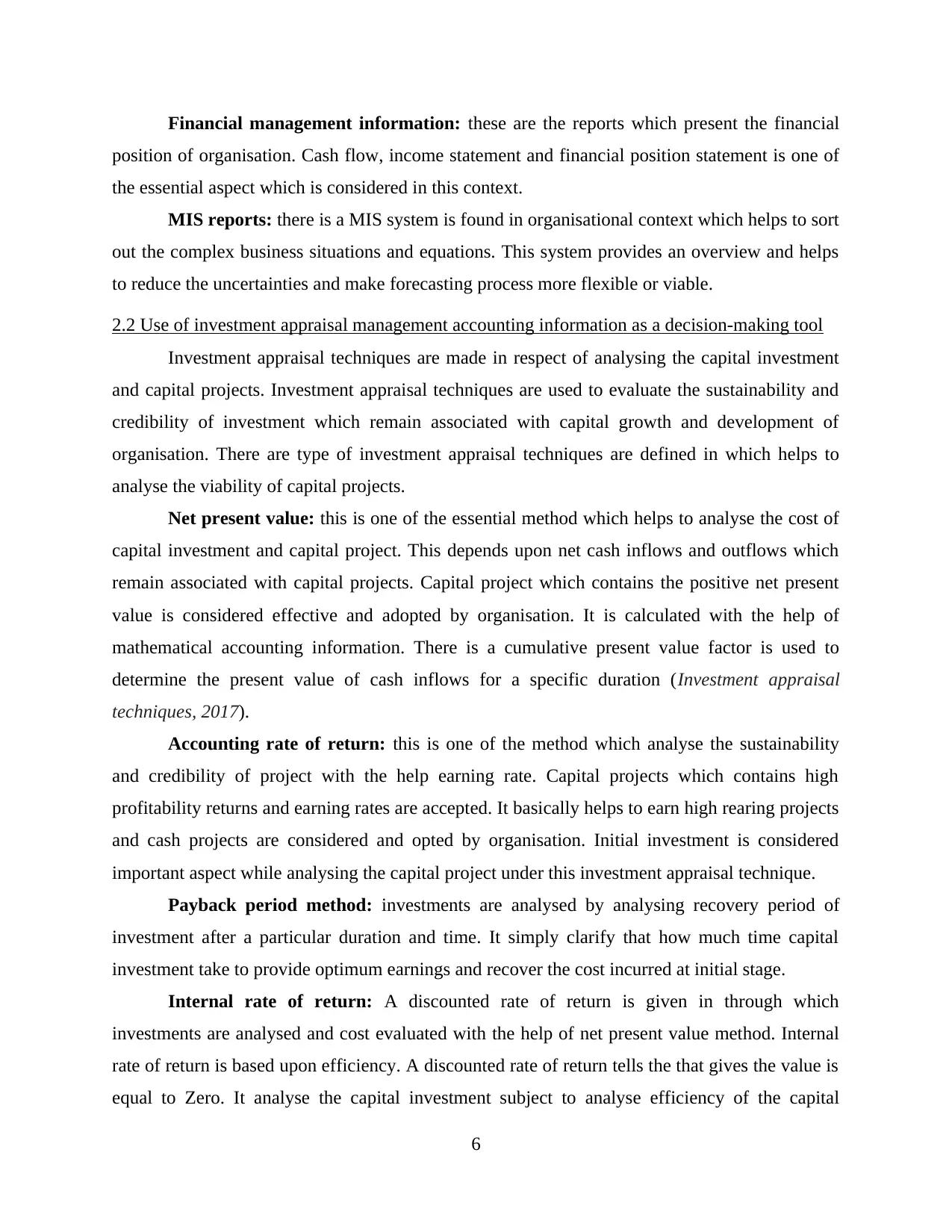
Financial management information: these are the reports which present the financial
position of organisation. Cash flow, income statement and financial position statement is one of
the essential aspect which is considered in this context.
MIS reports: there is a MIS system is found in organisational context which helps to sort
out the complex business situations and equations. This system provides an overview and helps
to reduce the uncertainties and make forecasting process more flexible or viable.
2.2 Use of investment appraisal management accounting information as a decision-making tool
Investment appraisal techniques are made in respect of analysing the capital investment
and capital projects. Investment appraisal techniques are used to evaluate the sustainability and
credibility of investment which remain associated with capital growth and development of
organisation. There are type of investment appraisal techniques are defined in which helps to
analyse the viability of capital projects.
Net present value: this is one of the essential method which helps to analyse the cost of
capital investment and capital project. This depends upon net cash inflows and outflows which
remain associated with capital projects. Capital project which contains the positive net present
value is considered effective and adopted by organisation. It is calculated with the help of
mathematical accounting information. There is a cumulative present value factor is used to
determine the present value of cash inflows for a specific duration (Investment appraisal
techniques, 2017).
Accounting rate of return: this is one of the method which analyse the sustainability
and credibility of project with the help earning rate. Capital projects which contains high
profitability returns and earning rates are accepted. It basically helps to earn high rearing projects
and cash projects are considered and opted by organisation. Initial investment is considered
important aspect while analysing the capital project under this investment appraisal technique.
Payback period method: investments are analysed by analysing recovery period of
investment after a particular duration and time. It simply clarify that how much time capital
investment take to provide optimum earnings and recover the cost incurred at initial stage.
Internal rate of return: A discounted rate of return is given in through which
investments are analysed and cost evaluated with the help of net present value method. Internal
rate of return is based upon efficiency. A discounted rate of return tells the that gives the value is
equal to Zero. It analyse the capital investment subject to analyse efficiency of the capital
6
position of organisation. Cash flow, income statement and financial position statement is one of
the essential aspect which is considered in this context.
MIS reports: there is a MIS system is found in organisational context which helps to sort
out the complex business situations and equations. This system provides an overview and helps
to reduce the uncertainties and make forecasting process more flexible or viable.
2.2 Use of investment appraisal management accounting information as a decision-making tool
Investment appraisal techniques are made in respect of analysing the capital investment
and capital projects. Investment appraisal techniques are used to evaluate the sustainability and
credibility of investment which remain associated with capital growth and development of
organisation. There are type of investment appraisal techniques are defined in which helps to
analyse the viability of capital projects.
Net present value: this is one of the essential method which helps to analyse the cost of
capital investment and capital project. This depends upon net cash inflows and outflows which
remain associated with capital projects. Capital project which contains the positive net present
value is considered effective and adopted by organisation. It is calculated with the help of
mathematical accounting information. There is a cumulative present value factor is used to
determine the present value of cash inflows for a specific duration (Investment appraisal
techniques, 2017).
Accounting rate of return: this is one of the method which analyse the sustainability
and credibility of project with the help earning rate. Capital projects which contains high
profitability returns and earning rates are accepted. It basically helps to earn high rearing projects
and cash projects are considered and opted by organisation. Initial investment is considered
important aspect while analysing the capital project under this investment appraisal technique.
Payback period method: investments are analysed by analysing recovery period of
investment after a particular duration and time. It simply clarify that how much time capital
investment take to provide optimum earnings and recover the cost incurred at initial stage.
Internal rate of return: A discounted rate of return is given in through which
investments are analysed and cost evaluated with the help of net present value method. Internal
rate of return is based upon efficiency. A discounted rate of return tells the that gives the value is
equal to Zero. It analyse the capital investment subject to analyse efficiency of the capital
6
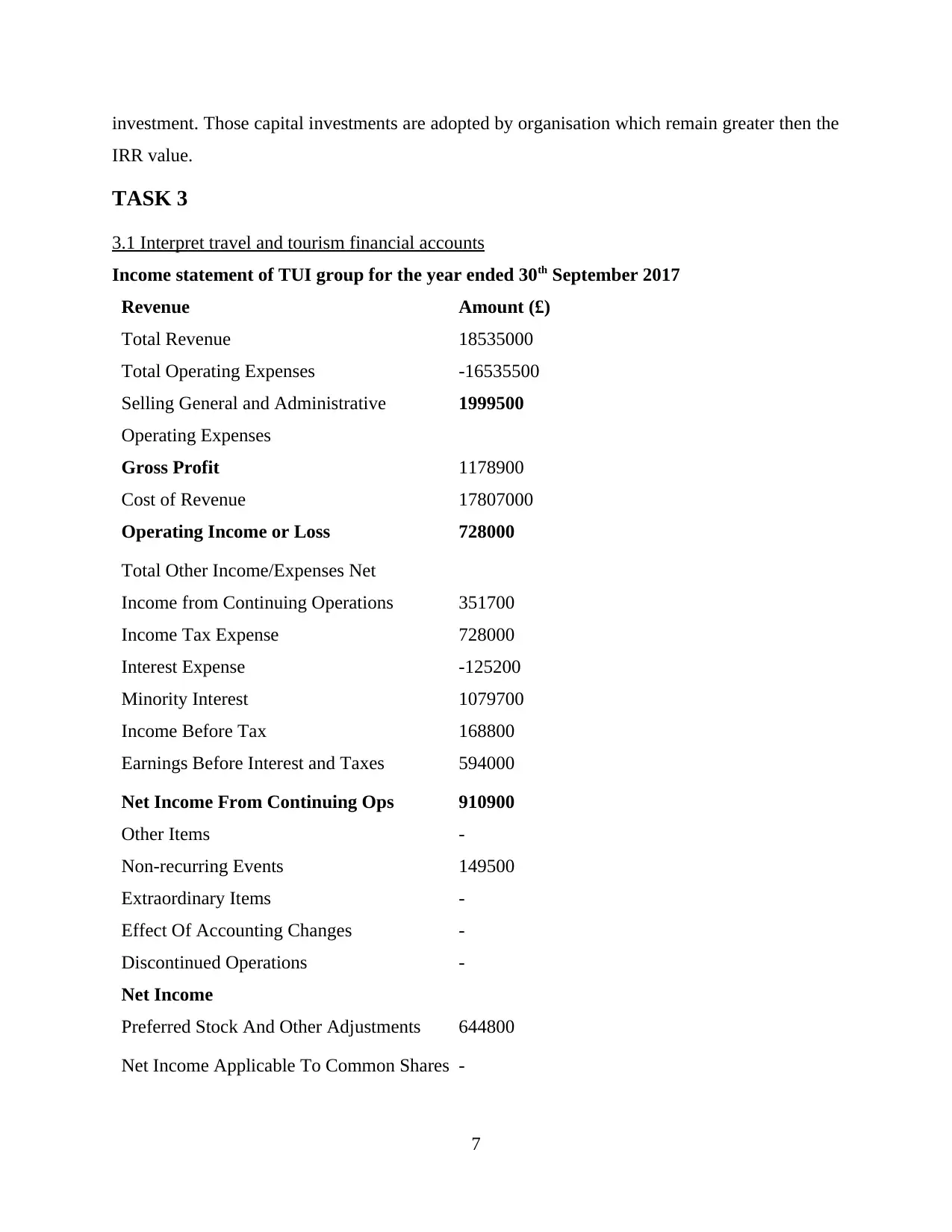
investment. Those capital investments are adopted by organisation which remain greater then the
IRR value.
TASK 3
3.1 Interpret travel and tourism financial accounts
Income statement of TUI group for the year ended 30th September 2017
Revenue Amount (£)
Total Revenue 18535000
Total Operating Expenses -16535500
Selling General and Administrative 1999500
Operating Expenses
Gross Profit 1178900
Cost of Revenue 17807000
Operating Income or Loss 728000
Total Other Income/Expenses Net
Income from Continuing Operations 351700
Income Tax Expense 728000
Interest Expense -125200
Minority Interest 1079700
Income Before Tax 168800
Earnings Before Interest and Taxes 594000
Net Income From Continuing Ops 910900
Other Items -
Non-recurring Events 149500
Extraordinary Items -
Effect Of Accounting Changes -
Discontinued Operations -
Net Income
Preferred Stock And Other Adjustments 644800
Net Income Applicable To Common Shares -
7
IRR value.
TASK 3
3.1 Interpret travel and tourism financial accounts
Income statement of TUI group for the year ended 30th September 2017
Revenue Amount (£)
Total Revenue 18535000
Total Operating Expenses -16535500
Selling General and Administrative 1999500
Operating Expenses
Gross Profit 1178900
Cost of Revenue 17807000
Operating Income or Loss 728000
Total Other Income/Expenses Net
Income from Continuing Operations 351700
Income Tax Expense 728000
Interest Expense -125200
Minority Interest 1079700
Income Before Tax 168800
Earnings Before Interest and Taxes 594000
Net Income From Continuing Ops 910900
Other Items -
Non-recurring Events 149500
Extraordinary Items -
Effect Of Accounting Changes -
Discontinued Operations -
Net Income
Preferred Stock And Other Adjustments 644800
Net Income Applicable To Common Shares -
7
⊘ This is a preview!⊘
Do you want full access?
Subscribe today to unlock all pages.

Trusted by 1+ million students worldwide
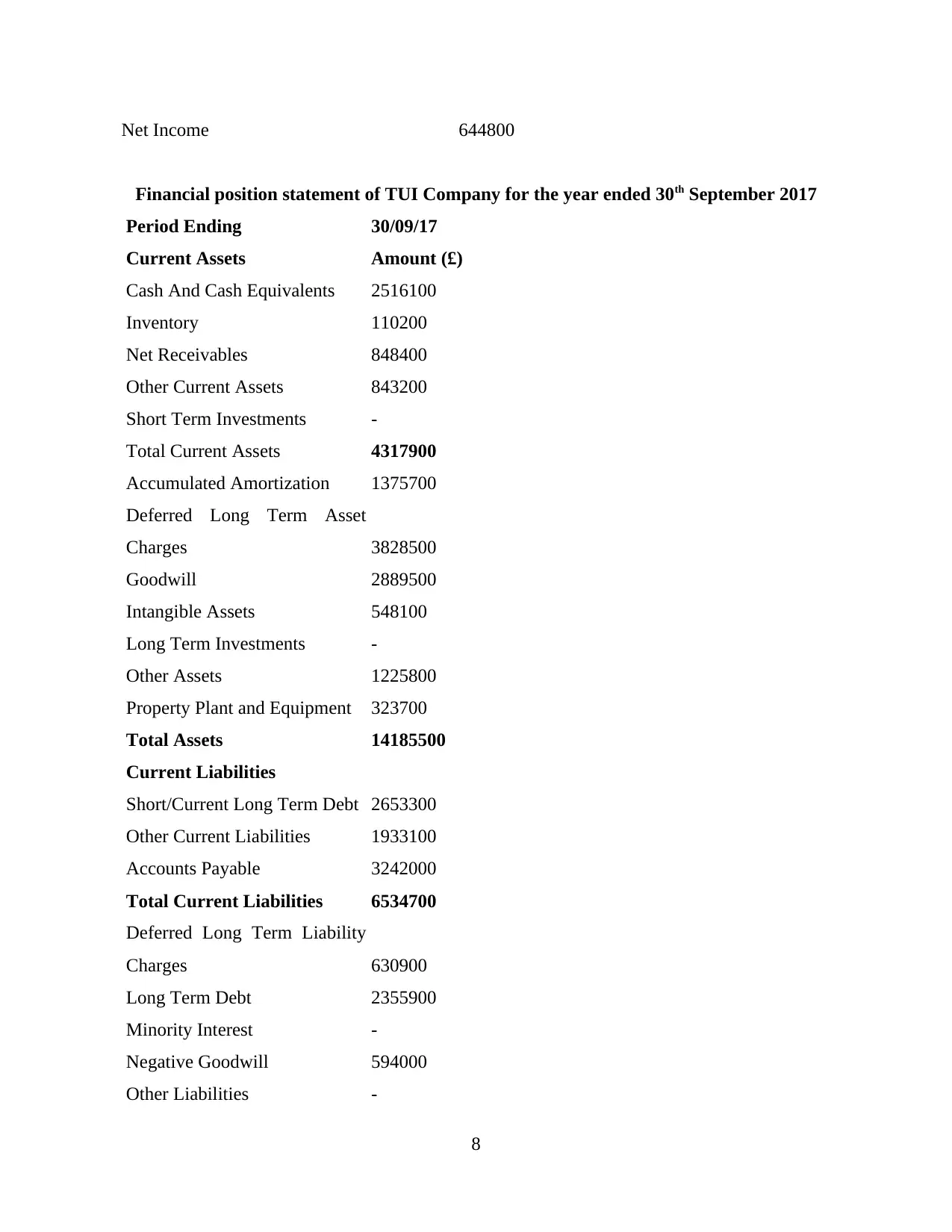
Net Income 644800
Financial position statement of TUI Company for the year ended 30th September 2017
Period Ending 30/09/17
Current Assets Amount (£)
Cash And Cash Equivalents 2516100
Inventory 110200
Net Receivables 848400
Other Current Assets 843200
Short Term Investments -
Total Current Assets 4317900
Accumulated Amortization 1375700
Deferred Long Term Asset
Charges 3828500
Goodwill 2889500
Intangible Assets 548100
Long Term Investments -
Other Assets 1225800
Property Plant and Equipment 323700
Total Assets 14185500
Current Liabilities
Short/Current Long Term Debt 2653300
Other Current Liabilities 1933100
Accounts Payable 3242000
Total Current Liabilities 6534700
Deferred Long Term Liability
Charges 630900
Long Term Debt 2355900
Minority Interest -
Negative Goodwill 594000
Other Liabilities -
8
Financial position statement of TUI Company for the year ended 30th September 2017
Period Ending 30/09/17
Current Assets Amount (£)
Cash And Cash Equivalents 2516100
Inventory 110200
Net Receivables 848400
Other Current Assets 843200
Short Term Investments -
Total Current Assets 4317900
Accumulated Amortization 1375700
Deferred Long Term Asset
Charges 3828500
Goodwill 2889500
Intangible Assets 548100
Long Term Investments -
Other Assets 1225800
Property Plant and Equipment 323700
Total Assets 14185500
Current Liabilities
Short/Current Long Term Debt 2653300
Other Current Liabilities 1933100
Accounts Payable 3242000
Total Current Liabilities 6534700
Deferred Long Term Liability
Charges 630900
Long Term Debt 2355900
Minority Interest -
Negative Goodwill 594000
Other Liabilities -
8
Paraphrase This Document
Need a fresh take? Get an instant paraphrase of this document with our AI Paraphraser
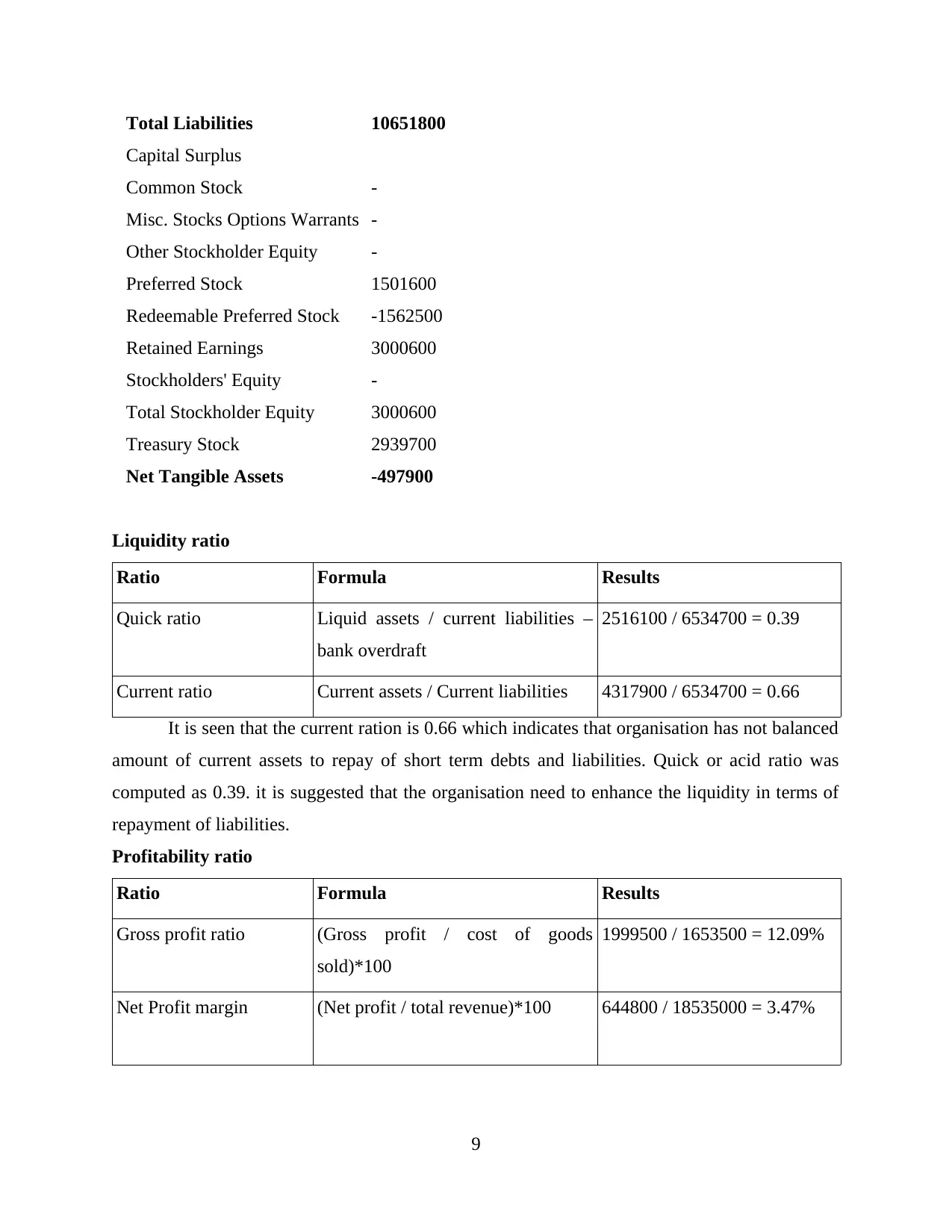
Total Liabilities 10651800
Capital Surplus
Common Stock -
Misc. Stocks Options Warrants -
Other Stockholder Equity -
Preferred Stock 1501600
Redeemable Preferred Stock -1562500
Retained Earnings 3000600
Stockholders' Equity -
Total Stockholder Equity 3000600
Treasury Stock 2939700
Net Tangible Assets -497900
Liquidity ratio
Ratio Formula Results
Quick ratio Liquid assets / current liabilities –
bank overdraft
2516100 / 6534700 = 0.39
Current ratio Current assets / Current liabilities 4317900 / 6534700 = 0.66
It is seen that the current ration is 0.66 which indicates that organisation has not balanced
amount of current assets to repay of short term debts and liabilities. Quick or acid ratio was
computed as 0.39. it is suggested that the organisation need to enhance the liquidity in terms of
repayment of liabilities.
Profitability ratio
Ratio Formula Results
Gross profit ratio (Gross profit / cost of goods
sold)*100
1999500 / 1653500 = 12.09%
Net Profit margin (Net profit / total revenue)*100 644800 / 18535000 = 3.47%
9
Capital Surplus
Common Stock -
Misc. Stocks Options Warrants -
Other Stockholder Equity -
Preferred Stock 1501600
Redeemable Preferred Stock -1562500
Retained Earnings 3000600
Stockholders' Equity -
Total Stockholder Equity 3000600
Treasury Stock 2939700
Net Tangible Assets -497900
Liquidity ratio
Ratio Formula Results
Quick ratio Liquid assets / current liabilities –
bank overdraft
2516100 / 6534700 = 0.39
Current ratio Current assets / Current liabilities 4317900 / 6534700 = 0.66
It is seen that the current ration is 0.66 which indicates that organisation has not balanced
amount of current assets to repay of short term debts and liabilities. Quick or acid ratio was
computed as 0.39. it is suggested that the organisation need to enhance the liquidity in terms of
repayment of liabilities.
Profitability ratio
Ratio Formula Results
Gross profit ratio (Gross profit / cost of goods
sold)*100
1999500 / 1653500 = 12.09%
Net Profit margin (Net profit / total revenue)*100 644800 / 18535000 = 3.47%
9
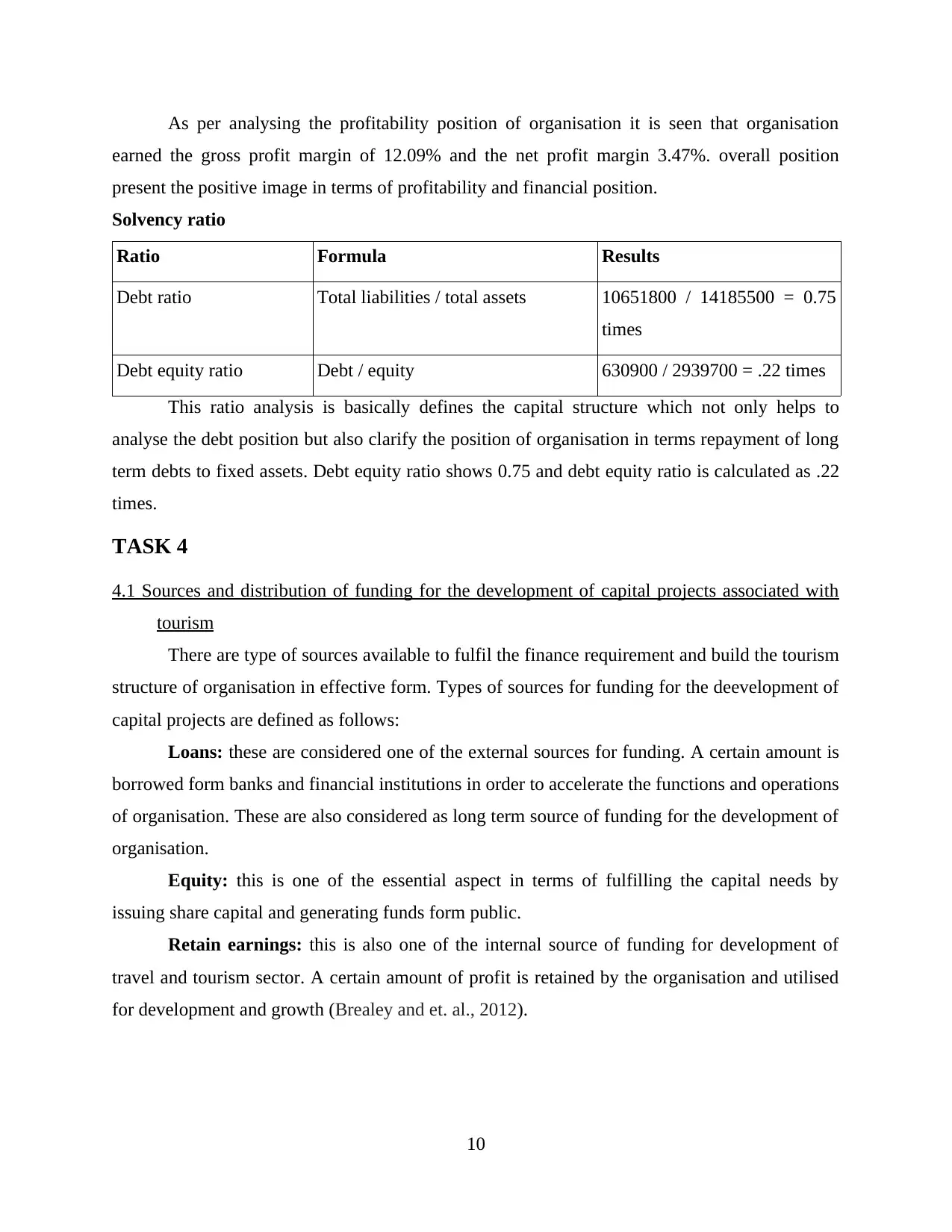
As per analysing the profitability position of organisation it is seen that organisation
earned the gross profit margin of 12.09% and the net profit margin 3.47%. overall position
present the positive image in terms of profitability and financial position.
Solvency ratio
Ratio Formula Results
Debt ratio Total liabilities / total assets 10651800 / 14185500 = 0.75
times
Debt equity ratio Debt / equity 630900 / 2939700 = .22 times
This ratio analysis is basically defines the capital structure which not only helps to
analyse the debt position but also clarify the position of organisation in terms repayment of long
term debts to fixed assets. Debt equity ratio shows 0.75 and debt equity ratio is calculated as .22
times.
TASK 4
4.1 Sources and distribution of funding for the development of capital projects associated with
tourism
There are type of sources available to fulfil the finance requirement and build the tourism
structure of organisation in effective form. Types of sources for funding for the deevelopment of
capital projects are defined as follows:
Loans: these are considered one of the external sources for funding. A certain amount is
borrowed form banks and financial institutions in order to accelerate the functions and operations
of organisation. These are also considered as long term source of funding for the development of
organisation.
Equity: this is one of the essential aspect in terms of fulfilling the capital needs by
issuing share capital and generating funds form public.
Retain earnings: this is also one of the internal source of funding for development of
travel and tourism sector. A certain amount of profit is retained by the organisation and utilised
for development and growth (Brealey and et. al., 2012).
10
earned the gross profit margin of 12.09% and the net profit margin 3.47%. overall position
present the positive image in terms of profitability and financial position.
Solvency ratio
Ratio Formula Results
Debt ratio Total liabilities / total assets 10651800 / 14185500 = 0.75
times
Debt equity ratio Debt / equity 630900 / 2939700 = .22 times
This ratio analysis is basically defines the capital structure which not only helps to
analyse the debt position but also clarify the position of organisation in terms repayment of long
term debts to fixed assets. Debt equity ratio shows 0.75 and debt equity ratio is calculated as .22
times.
TASK 4
4.1 Sources and distribution of funding for the development of capital projects associated with
tourism
There are type of sources available to fulfil the finance requirement and build the tourism
structure of organisation in effective form. Types of sources for funding for the deevelopment of
capital projects are defined as follows:
Loans: these are considered one of the external sources for funding. A certain amount is
borrowed form banks and financial institutions in order to accelerate the functions and operations
of organisation. These are also considered as long term source of funding for the development of
organisation.
Equity: this is one of the essential aspect in terms of fulfilling the capital needs by
issuing share capital and generating funds form public.
Retain earnings: this is also one of the internal source of funding for development of
travel and tourism sector. A certain amount of profit is retained by the organisation and utilised
for development and growth (Brealey and et. al., 2012).
10
⊘ This is a preview!⊘
Do you want full access?
Subscribe today to unlock all pages.

Trusted by 1+ million students worldwide
1 out of 13
Related Documents
Your All-in-One AI-Powered Toolkit for Academic Success.
+13062052269
info@desklib.com
Available 24*7 on WhatsApp / Email
![[object Object]](/_next/static/media/star-bottom.7253800d.svg)
Unlock your academic potential
Copyright © 2020–2025 A2Z Services. All Rights Reserved. Developed and managed by ZUCOL.





